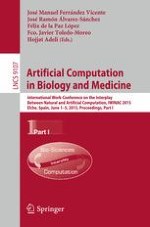2015 | OriginalPaper | Buchkapitel
Toward an Upper-Limb Neurorehabilitation Platform Based on FES-Assisted Bilateral Movement: Decoding User’s Intentionality
verfasst von : Andres Felipe Ruiz-Olaya, Alberto López-Delis, Alexander Cerquera
Erschienen in: Artificial Computation in Biology and Medicine
Aktivieren Sie unsere intelligente Suche, um passende Fachinhalte oder Patente zu finden.
Wählen Sie Textabschnitte aus um mit Künstlicher Intelligenz passenden Patente zu finden. powered by
Markieren Sie Textabschnitte, um KI-gestützt weitere passende Inhalte zu finden. powered by
In the last years there has been a noticeable progress in motor learning, neuroplasticity and functional recovery after the occurrence of brain lesion. Rehabilitation of motor function has been associated to motor learning that occurs during repetitive, frequent and intensive training. Neuro-rehabilitation is based on the assumption that motor learning principles can be applied to motor recovery after injury, and that training can lead to permanent improvements of motor functions in patients with muscle deficits. The emergent research field of Rehabilitation Engineering may provide promise technologies for neuro-rehabilitation therapies, exploiting the motor learning and neural plasticity concepts. Among those technologies, the FES-assisted systems could provide repetitive training-based therapies and have been developed to aid or control the upper and lower limbs movements in response to user’s intentionality. Surface electromyography (SEMG) reflects directly the human motion intention, so it can be used as input information to control an active FES-assisted system. The present work describes a neurorehabilitation platform at the upper-limb level, based on bilateral coordination training (i.e. mirror movements with the unaffected arm) using a close-loop active FES system controlled by user. In this way, this work presents a novel myoelectric controller for decoding movements of user to be employed in a neurorehabilitation platform. It was carried out a set of experiments to validate the myoelectric controller in classification of seven human upper-limb movements, obtaining an average classification error of 4.3%. The results suggest that the proposed myoelectric pattern recognition method may be applied to control close-loop FES system.
